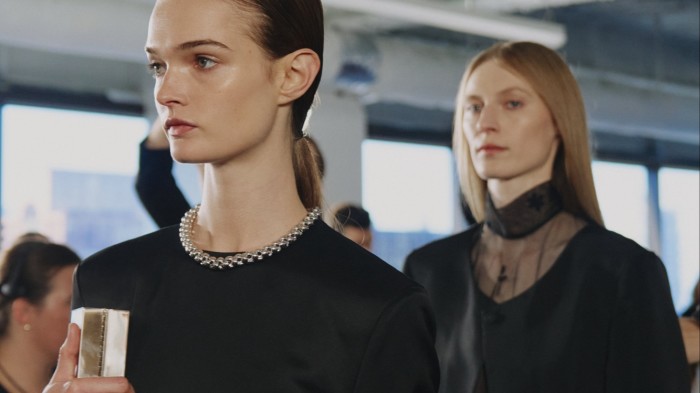Stay informed with free updates
Simply sign up to the Fashion myFT Digest — delivered directly to your inbox.
Minimalism is perhaps the easiest fashion trend to pull off: the less you do, the better. A handful of brands are propelling today’s practical and durable minimalist agenda forward, convincing consumers to forgo branding and other complexities in favour of sleek simplicity.
The leader is New York label The Row, whose sumptuous cashmere, pleat-front trousers and slip-on shoes have garnered a global and devoted following. Also in New York are Khaite, Another Tomorrow and Kallmeyer, while across the Atlantic there’s Toteme in Stockholm, Dušan in Milan and Tove in London – all of which are putting their own stamps on minimalism. “Our collections are designed for the woman who values our core principles, embracing simplicity and innovation,” says Tove co-founder and creative director Holly Wright. “Most of the ready-to-wear collections bring newness but they are still respectful of the past.”
Historical references usually laud the 1990s as the apex of minimalism in fashion, and brands including Jil Sander, Prada and Helmut Lang certainly created a visual shorthand for the decade. Calvin Klein, who always exercised restraint in his designs, cemented New York as the heart of the movement, with collections that featured silky slips, little black dresses, colour-blocked separates and slick suiting. He also influenced the dress sense of Manhattan high society: in particular, Carolyn Bessette-Kennedy, who handled PR at Calvin Klein, and whose uniform of crisp white shirts, mannish trousers and silk skirts became a template for the minimalist wardrobe that has remained current to this day.
The seesaw between minimalism and maximalism is often thought to reflect economic and social movements: in downturns, clothing becomes austere and practical, while in boom times it’s more decorative and frivolous. “It’s an oversimplification to say that as a blanket statement, but it does tend to play into the story,” says Melissa Marra-Alvarez, curator of education and research at The Museum at FIT. She offers Coco Chanel’s little black dress, which was introduced in the roaring 1920s as a timeless, affordable and accessible frock for all social classes, as an example. “Each time it’s reacting and adapting to a new period based on the cultural climate of the time and also the styles that preceded it.”
The sustained success of the minimalist look in the current fashion climate could be a sign of economic uncertainty, but there are other factors at play. While the much-trumpeted idea of “quiet luxury” champions good, practical design in its purest form, the look is also about belonging to an insider’s club, for which membership is granted to those that can see and appreciate subtle design. And afford it. “The Row is about this idea of connoisseurship, and having the knowledge to recognise good-quality things, and what wonderful fabrics feel like,” says Marra-Alvarez. “Minimalism will always have enduring appeal for the woman who values quiet, refined sophistication,” adds Tove co-founder Camille Perry.
Additionally, the minimalist principles of timelessness and quality are integral to sustainability, and the ethos of buying fewer but better clothes. That’s certainly one of the driving forces for Tove, as well as Serbian designer Dušan Paunovic. “Trends come and go, but I believe in creating pieces that transcend seasonal shifts,” says Paunovic. “My approach is rooted in designing garments that are timeless, functional, and versatile – wardrobe essentials that offer longevity rather than fleeting appeal. This allows my customers to build a sustainable wardrobe where each item has a lasting value and is not tied to short-lived fashion cycles. For me, minimalism is not just a style but a way of simplifying choices, creating a uniform that resonates with my principles of form, function and subtle sophistication.”
Stockholm
Toteme
Elin Kling founded Toteme with her art-director partner Karl Lindman in 2014 off the back of the success of her fashion blog Style by Kling. The brand started with a “uniform” approach, creating well-designed basics that echoed a distinct Scandinavian minimalism while selling them at an accessible price point. Toteme has since pushed into more upmarket territory, showing at New York Fashion Week for SS25 with a collection of fluid, drapey silhouettes. The brand has found a niche in elevated wardrobe staples with a subtle edge – such as its bestselling scarf coat (£810) and billowing striped roll-neck sweater (£420).
Milan
Dušan

Serbian-born Dušan Paunovic might be one of Milan’s most underrated designers. Since 1999, he has been creating refined designs at odds with the fashion capital’s flashy sensibilities, and has a loyal base of customers. Paunovic started his career in the ’90s at Zoran, where he learnt that minimalism was not a style but a philosophy, and his ready-to-wear has followed: his signature tailored coat (from €1,500) has barely changed since its inception, while his relaxed trousers (from €900) balance form and function.
London
Tove

Founders Camille Perry and Holly Wright are a rarity on the London Fashion Week calendar, showing sleek, wearable clothes in a city that more readily champions the avant-garde. The ex-Topshop employees founded Tove in 2019 and quickly found an audience for their sharp suiting, sculptural coats and elegant eveningwear that plays with subtle embellishments and transparent details. While the brand has had a hit with its denim, it is perhaps best known for its dresses, such as the Ceres (£545) – a sleeveless summer frock with ruching and ties at the front – and the twist-front Jessa (£845).
New York
Khaite

In 2019, actor Katie Holmes was photographed walking around New York wearing a cashmere cardigan and matching bra by Khaite; the subsequent interest transformed the brand’s fortunes. Since then, designer Catherine Holstein has grown Khaite, which she founded in 2016, into a key player in New York, creating minimalist silhouettes with a decidedly feminine touch. As Holstein told the FT in 2020: “It’s really hard for me to get dressed up… I don’t want to feel like a cupcake.” With seven stores globally and recent investment from growth equity firm Stripes, Khaite is fast becoming a major American luxury brand.
Source link












